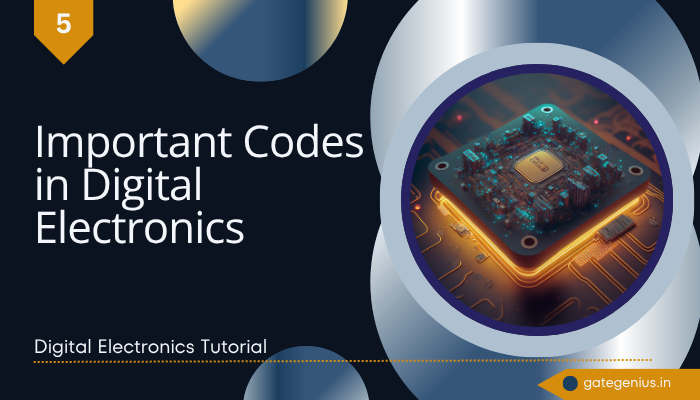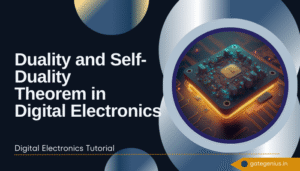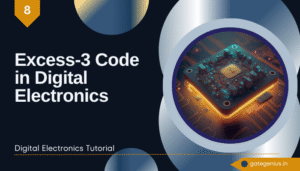In the world of digital electronics, codes are essential tools that allow electronic devices to represent, process, and communicate information efficiently. These codes in digital electronics translate real-world data such as numbers, characters, and signals into binary formats that machines can understand. Different coding schemes are designed to meet specific needs — whether it’s simplifying arithmetic operations, reducing transmission errors, or ensuring compatibility between diverse hardware and software systems. Among the most important codes are Binary Coded Decimal (BCD), Gray Code, Excess-3, ASCII, and EBCDIC, each with its unique structure and applications. This article explores these essential codes, explaining their significance and how they contribute to the seamless functioning of modern digital systems.
In this blog, we’ll explore five important codes that play a vital role in digital electronics:
- BCD (Binary Coded Decimal)
- Gray Code
- Excess-3 Code
- ASCII (American Standard Code for Information Interchange)
- EBCDIC (Extended Binary Coded Decimal Interchange Code)
Binary Coded Decimal (BCD)
BCD is a binary representation of decimal numbers. In this system, each digit of a decimal number is represented separately using a 4-bit binary code. BCD in digital electronics is commonly used in applications like digital clocks, calculators, and digital meters, where numeric data is displayed and needs to match the decimal system closely. This format simplifies hardware design for numeric displays and avoids conversion errors associated with floating-point or binary arithmetic.
Example:
Decimal Number: 47
BCD: 4 → 0100, 7 → 0111
Result: 0100 0111
Features:
- Only binary combinations from 0000 (0) to 1001 (9) are valid.
- Easy conversion between binary and decimal for human-readable displays.
- Less efficient for arithmetic due to unused binary combinations.
Applications:
- Digital clocks
- Calculators
- Microcontroller displays
- Digital meters
Gray Code (Reflected Binary Code)
Gray Code is a binary numbering system where two successive numbers differ in only one bit. This unique property helps minimize errors during digital transitions, especially in systems where multiple bits change simultaneously can lead to incorrect or unstable outputs. Gray Code is also known as Reflected Binary Code because the sequence is generated by reflecting the binary code and adding a prefix.
It is especially useful in mechanical encoders, error correction in digital communication, and analog-to-digital converters where precise and error-free bit transitions are critical. Gray Code in digital electronics is widely applied in position sensors, rotary encoders, Karnaugh maps, and various digital systems to reduce the chances of glitches during state changes. By ensuring that only one bit changes at a time, Gray Code enhances reliability in digital circuits and improves performance in timing-sensitive applications.
Example:
Decimal 0–7 in Binary and Gray Code:
| Decimal | Binary | Gray Code |
|---|---|---|
| 0 | 000 | 000 |
| 1 | 001 | 001 |
| 2 | 010 | 011 |
| 3 | 011 | 010 |
| 4 | 100 | 110 |
| 5 | 101 | 111 |
| 6 | 110 | 101 |
| 7 | 111 | 100 |
Features:
- Only one bit changes between consecutive numbers.
- Reduces logic errors and glitches.
Applications:
- Rotary encoders
- Analog to Digital Converters (ADC)
- Digital communication systems
Excess-3 Code (XS-3)
Excess-3 is a non-weighted and self-complementary binary-coded decimal code derived by adding 3 (0011 in binary) to each digit of the standard BCD representation. For example, the decimal digit 4 in BCD is 0100, and in Excess-3 code, it becomes 0111 (4 + 3 = 7). One of the main advantages of the Excess-3 Code in digital electronics is its self-complementary property, meaning the 9’s complement of a decimal digit can be obtained by simply inverting the bits of its Excess-3 representation. This feature simplifies arithmetic operations and error detection in digital systems. Excess-3 code is often used in digital systems like calculators and digital clocks where error detection and simple subtraction operations are important.
It also helps reduce the complexity of designing hardware for decimal arithmetic, compared to straight BCD. Because it’s a non-weighted code, each digit’s value is not directly derived from the bit positions but through the code’s specific structure, making it useful in specific coding and decoding applications.Excess-3 is a non-weighted and self-complementary code derived by adding 3 (0011) to each digit in BCD format.
Example:
Decimal: 5
BCD: 0101
Excess-3: 0101 + 0011 = 1000
Features:
- Each digit is represented using 4 bits.
- Self-complementary nature helps in subtraction operations.
- No need for separate subtraction logic.
Applications:
- Digital arithmetic circuits
- Error detection
- Digital systems using decimal arithmetic
ASCII (American Standard Code for Information Interchange)
ASCII is a 7-bit binary code that represents text characters, digits, punctuation marks, and control symbols. It provides a standardized way to encode alphanumeric data so that different digital devices and communication systems can interpret and exchange information consistently. The 7-bit structure allows for 128 unique symbols, including uppercase and lowercase letters, numbers 0-9, and special characters like newline, tab, and backspace.
In addition to its fundamental role in computer programming and data processing, the ASCII code in digital electronics is crucial for interfacing digital systems with human-readable data. For example, microcontrollers, digital displays, and communication interfaces often rely on ASCII to convert binary signals into readable text on screens or transmit commands. Despite newer character encoding standards like Unicode, ASCII remains foundational due to its simplicity, efficiency, and widespread support in digital electronics and embedded systems.
Example:
| Character | ASCII (Decimal) | ASCII (Binary) |
|---|---|---|
| A | 65 | 1000001 |
| a | 97 | 1100001 |
| 0 | 48 | 0110000 |
Features:
- 128 characters including uppercase, lowercase, digits, and symbols.
- Widely used in computer systems, internet communication, and programming.
Applications:
- Text encoding in software
- Data communication protocols
- Programming languages and compilers
EBCDIC (Extended Binary Coded Decimal Interchange Code)
EBCDIC is an 8-bit character encoding system developed by IBM to extend the capabilities of earlier binary-coded decimal systems. Unlike the more universally adopted ASCII, EBCDIC is primarily used in IBM mainframe and legacy computer systems. It supports a larger set of characters, including control characters, letters, digits, and special symbols, organized differently from ASCII. In many legacy applications, especially in banking, insurance, and large enterprise environments, EBCDIC in digital electronics plays a vital role in ensuring compatibility and data integrity during processing and communication.
Although modern systems have largely transitioned to ASCII and Unicode standards, EBCDIC remains important for interfacing with older hardware and software systems. Its distinct binary patterns also affect how data is encoded, transmitted, and decoded within these digital electronic systems, requiring specialized converters or software when integrating with non-EBCDIC environments.
Example:
| Character | EBCDIC (Hex) |
|---|---|
| A | C1 |
| a | 81 |
| 0 | F0 |
Features:
- Supports 256 characters.
- Not compatible with ASCII.
- Still found in old banking systems and IBM mainframes.
Applications:
- IBM mainframe computers
- Legacy financial software
- Data storage in older enterprise systems
Frequently Asked Questions?
Q1. What is the main difference between BCD and Excess-3 code?
A1. BCD directly represents decimal digits in binary, while Excess-3 adds 3 to each digit, which helps in arithmetic operations.
Q2. Why is Gray Code used in rotary encoders?
A2. Gray Code minimizes errors during transitions because only one bit changes at a time.
Q3. Is ASCII still relevant today?
A3. Yes. Although extended versions like UTF-8 are widely used, ASCII is the foundation of modern character encoding.
Q4. Where is EBCDIC used?
A4. EBCDIC is used mainly in IBM mainframes and legacy business applications.
Q5. What are the advantages of Excess-3 being self-complementary?
A5. It simplifies subtraction logic and reduces errors in digital arithmetic operations.
Conclusion
In digital electronics, coding systems like BCD, Gray, Excess-3, ASCII, and EBCDIC play a foundational role in representing and processing data accurately and efficiently. Each code serves a unique purpose — BCD simplifies the display and manipulation of decimal numbers, Gray Code minimizes errors during digital transitions, Excess-3 facilitates easy arithmetic operations and error detection, while ASCII and EBCDIC standardize the representation of characters and control symbols for communication between diverse systems.
Together, these codes enable seamless interoperability between hardware and software, improve data integrity, and optimize system design across a wide range of digital applications, from microcontrollers and digital displays to large-scale mainframes and communication networks. Understanding these essential coding schemes is crucial for anyone working in digital electronics, as they form the backbone of reliable and error-free digital communication and computation.
I hope you understand the Important Codes in Digital Electronics: BCD, Gray, Excess-3, ASCII, and EBCDIC. So don’t forget to share this post with friends and anyone preparing for the GATE, UGC NET exams, or studying at the university.



